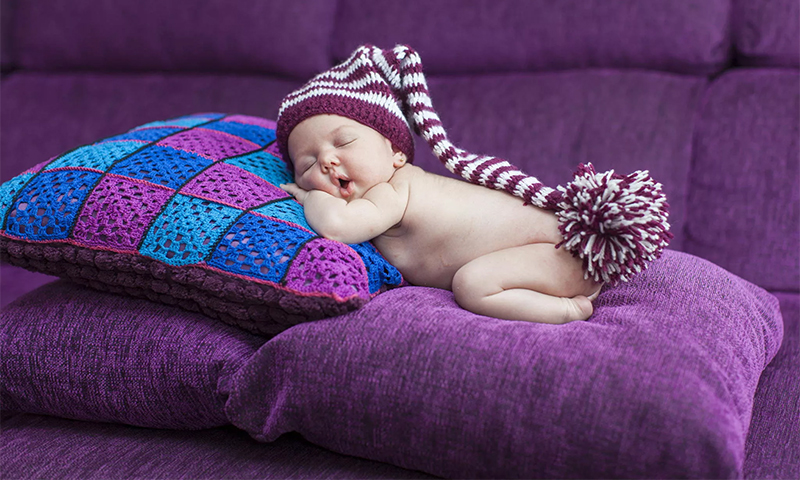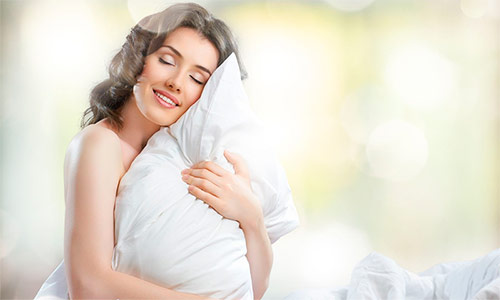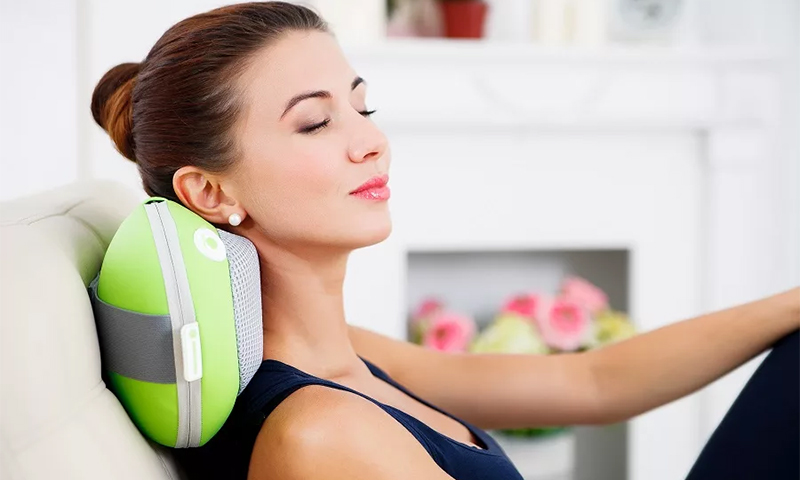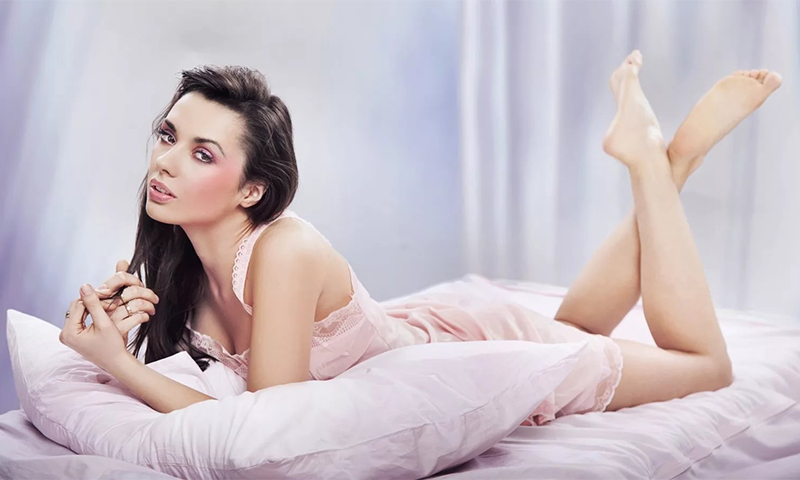Comfortable and soft blanket is necessary for a healthy and sound sleep. We wrap ourselves in it in the winter evenings, hide from the coolness of the night, and in the summer under a thin veil is somehow more comfortable. Our article on how to find a really good blanket, which will be nice to hide.
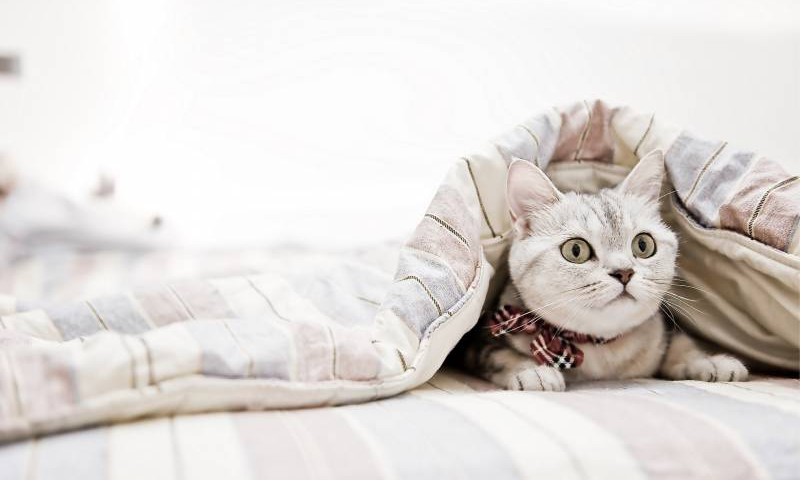
Content:
The best manufacturers of blankets - which company to choose
When choosing bedding, which you expect to use for several years, give preference to quality rather than to an over-affordable price - take products from reputable manufacturers.
The brand, which value its reputation, will not fall to the use of low-grade fillers and poisonous paints. The products of such companies comply with all sanitary and hygienic standards, as well as undergo a rigorous multistage control.
Excellent blankets for children and adults produce:
- Kariguz;
- Togas;
- Dargez;
- Ecotex;
- Nature’sS.
The prevalence of Russian manufacturers in the bedding market indicates the high quality and adequate price of their products. And the Soviet GOSTs, for which many of them work, inspire confidence.
We already told about the best blankets of these and other worthy companies in the article. Now let's see how to choose the right models for your family.
Types of blankets
Woolen

A blanket is the best choice for those who like to sleep a little longer or just lie in a bed. It retains heat well, is highly hygroscopic and dries quickly. And products made from sheep's wool (especially merino) also have healing properties.
Also on sale can be found models of wool camels, goats and llamas - usually they are available in the form of blankets or quilts.
Pros:
- Excellent thermal conductivity;
- Good hygroscopicity;
- Self-cleaning function (moisture and odors disappear quickly);
- A light weight;
- Long service life with proper care.
Minuses:
- They are afraid of moths;
- There are dust mites in the wool that can cause allergies.
Downy

The warmest and almost weightless blankets - it is comfortable to sleep under them even in hot summer. Goose and duck downs and feathers are most often used as stuffing; less often, looning down. If you purchase a combined product, the percentage of natural filler in the mixture should not be below 40%.
Also, when buying a blanket, you should pay attention to the quality of the quilting: it is better if the fabric is stitched in small squares.
Pros:
- They retain heat better than others;
- Very light, despite its thickness;
- They have excellent breathability;
- Elastic and very durable.
Minuses:
- Quickly damp;
- Require professional cleaning;
- Not suitable for allergy sufferers (dust mites are infused).
Cotton (cotton)
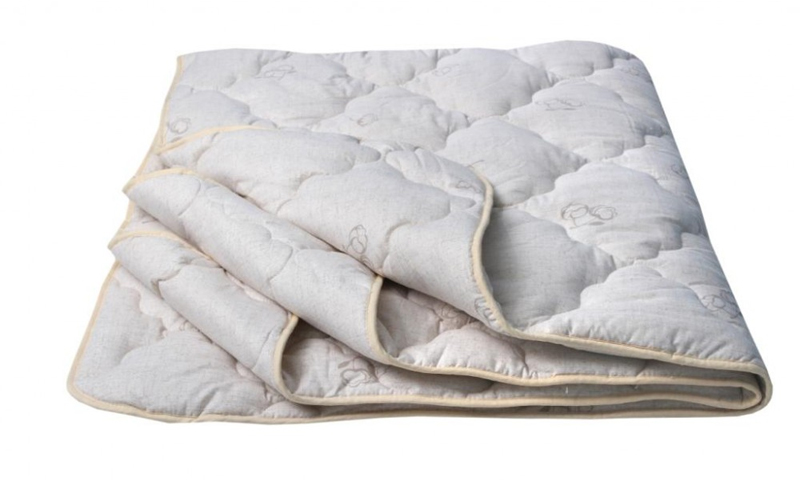
This type of filler was very common a few decades ago due to its affordable price and good heat-saving properties.
Today, this material is rapidly losing popularity due to the appearance of lighter and cheaper synthetic substitutes, which by many parameters are superior to obsolete cotton wool.
Pros:
- Good thermal conductivity;
- Hygroscopicity;
- Hypoallergenic;
- Usually have a very durable case.
Minuses:
- Easily absorb odors;
- Difficult to clean;
- Vata dampens with time and gets knotted;
- Great weight.
Silk
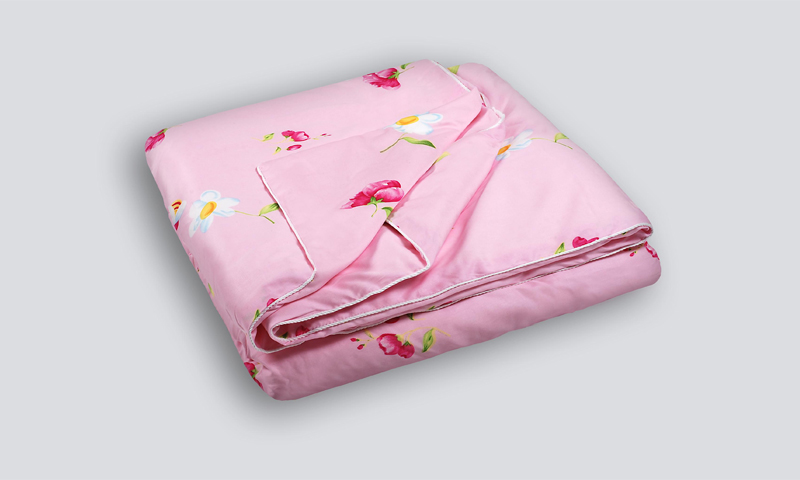
Belong to the category of luxury blankets. Stuffing material for them is made of specially processed cocoons of silkworms.
This fiber is very light and hygroscopic, and most importantly - microorganisms and mites do not start there.Silk blankets depending on the amount of filler are summer and winter.
Pros:
- Keep a stable temperature around the sleeper;
- Possess high air permeability;
- Hypoallergenic;
- Very durable.
Minuses:
- Difficult to care;
- Have a high cost.
Bamboo

Bamboo fiber went on sale not so long ago, but already has a whole army of fans. Blankets made of this material are not inferior in quality to silk: they remarkably let in air and absorb excess moisture. Such products keep their shape well and do not cause allergic reactions.
Pros:
- Antibacterial and antimicrobial properties;
- Air permeability;
- Hygroscopicity;
- Incredible softness;
- High environmental friendliness.
Minuses:
- High price;
- Not particularly warm;
- Short-lived - pure bamboo fiber will last no more than 2 seasons.
From eucalyptus

This filler is made from thin and fluffy fiber (cellulose) of eucalyptus - lyocel. It has a breathable structure and high strength. Like bamboo blankets, eucalyptus is not exposed to the invasion of mites and microbes, and are highly hygroscopic.
Pros:
- Absolutely hypoallergenic;
- Possess therapeutic and prophylactic properties;
- Maintain optimal temperature balance in summer and winter;
- Very light and soft;
- Do not accumulate static electricity.
Minuses:
- Price is above average;
- They require careful maintenance and regular airing.
Some manufacturers add synthetics to eucalyptus fiber, which significantly reduces the cost of the finished product and simplifies its maintenance. But the low price for such models is an occasion to study the label more closely.
When buying blankets with a mixed composition, make sure that the percentage of plant fibers is not lower than 50%.
Polyester (synthetic) blankets
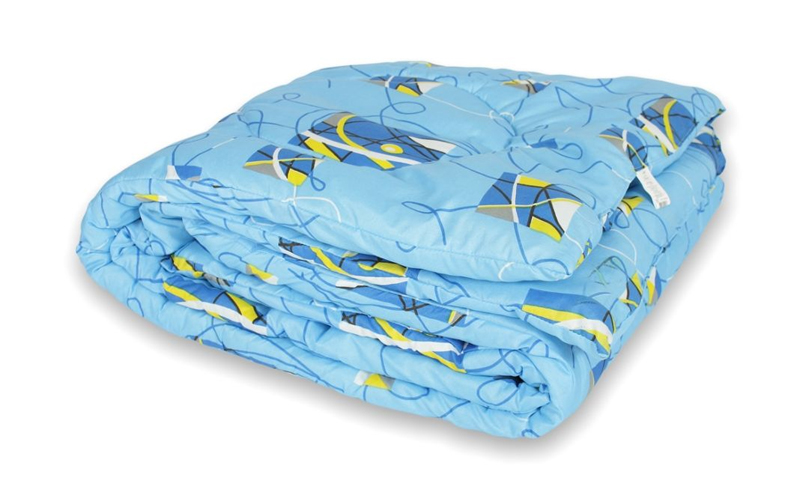
Modern synthetic fillers are almost as good as their “natural” counterparts in operational properties, but they have undoubted advantages: an affordable price and absolute hypoallergenicity.
Many people associate synthetics with something low-grade and low-quality. This is fundamentally not true. Most of the newest artificial materials (silicone, holofiber, microfiber, polyester) are very warm and durable. All of them are derived from polyester fiber, therefore, although they differ externally, they have similar qualities.
The sintepon is the cheapest in this family, but it can be deformed and lose volume. Soft and pleasant to the touch polyester properties resembles wool. As for the fashionable holofiber, consisting of spring fibers, it is not without reason that it is called “artificial fluff” - so this airy and lightweight filler is.
Pros:
- Absolute safety for health - saprophytes and pathogenic microbes do not start in synthetic fiber;
- Mostly very elastic, do not shrink or stretch;
- Possess excellent thermal insulation;
- Very light;
- Can be machine washed at high temperatures;
- Long service life (up to 10 years).
Minuses:
- Low hygroscopicity;
- Can accumulate static electricity.
Blanket selection options
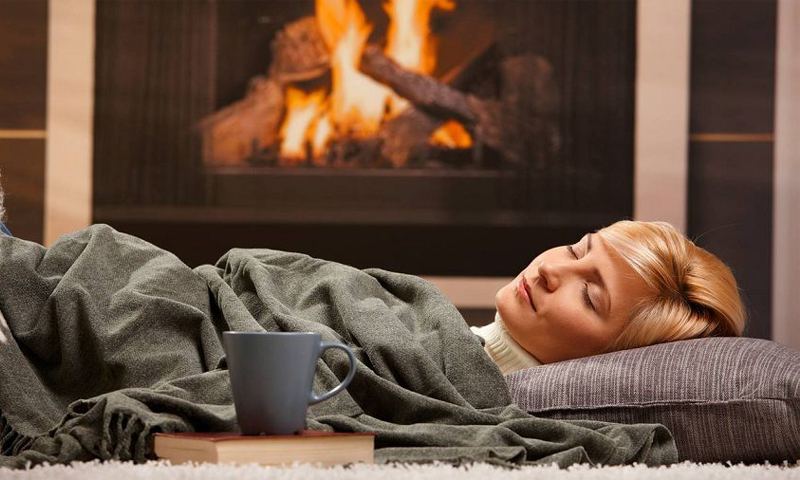
Sewing method
There are several technologies for sewing blankets used for various fillings:
1. Quilts are made using a special quilting machine, which sews a filler to the cover, punching through all the outer and inner layers. This method is suitable for sewing accessories with a solid, not crumbling filler: wool, cotton, vegetable and synthetic fibers.
2. If, instead of squares, a blanket is stitched with fantasy patterns, it means that you have a kosteppe model. Such products are more expensive, as often complex patterns are displayed manually.
3. Cassette method is used for sewing duvets and models with silicone balls. Here the product is divided into separate cells (cassettes), inside which the filler is poured.Due to the solid partitions, it does not "roam" around the cover and does not get off in the corners.
4. A special subtype of cassette technology is sewing blankets clusters. In this case, the sections on the canvas are stitched in a checkerboard pattern, which allows the filler to move inside the product. Shaking such a blanket, you can make it warmer in certain areas - for example, in the legs, if they are very cold.
Dimensions
The correct blanket should be the same length as the bed (if you chose it correctly for your own height), you can choose the width at your discretion.
For reference, we give the most common sizes of blankets, which are oriented and manufacturers of bed linen, but different factories, they may differ slightly.
1. One person will be satisfied with a one-and-a-half size - the domestic standard of 1.4x2.05 m or Euro 1.55x2.15 m;
2. Lovers who sleep together under one blanket need a double 1.72x2.05 m or 2x2.2 m. There are other, less common sizes 2x2 and 2.2x2.4 m.
3. Blankets are sold for newborns 1.1x1.4 and 1.2x1.2 m.
Cover material
Whatever the filling of the blanket, the material from which the cover is made is very important. It should be pleasant to the touch, durable, have a high hygroscopicity and breathability.
These properties can boast of natural fabrics: thick cotton, teak, satin. In expensive products also used silk.
Quality artificial fillers are often stitched into a dense and smooth polyester fabric. Some manufacturers (not cheap) additionally impregnate the fabric of covers with bactericidal, dirt-repellent, antistatic impregnations - with silver, aloe vera and other useful substances.
Degree of warmth
When buying blankets for different seasons, you should consider how warm they are. In addition, each person has its own peculiarities of thermoregulation. For example, older people are freezing even in summer, and for children overheating is simply dangerous.
The degree of heat is usually indicated by the manufacturer on the label or package of the product in the form of several suns:
1. Maximum 5 - a very warm blanket, in which the density of the filler exceeds 350 g / m2;
2. 4 - warm enough, density from 300 g / m2;
3. 3 - all-season (standard) product with an indicator up to 300 g / m2;
4. 2 - lightweight, has a filler weighing about 200-220 g / m2;
5. 1 - a very light summer blanket with a density of less than 200 g / m2.
What blanket to choose

1. For winter or just a cool room, the best choice would be a duvet cassette tailoring, as well as a woolen, wadded or polyester product of high quality with a cotton, teak or satin cover. These materials provide maximum thermal insulation. The degree of heat should not be below 4.
2. For a hot summer or a very warm bedroom, it is better to purchase a light quilt with silk or vegetable filling in a natural cover. You can take and down, but with a small degree of warmth - up to 2.
3. For off-season or moderate-temperature bedrooms, take blankets with vegetable or silk filling. Wool, fluff or low density synthetics are also suitable. The optimum degree of warmth is 3. Under such a blanket it will be warm in cool weather and not too hot in summer. The material of the cover can be chosen at your discretion: silk will give a slight sensation of coolness, cotton or teak will warm you better.
4. A practical choice would be a two-sided blanket. This product has a combined cover - fabric on the one hand and wool or even fur on the other. This can be either a one-piece blanket or a composite model, where both layers are joined by buttons, zippers, or strings. In the summer and in the offseason, they can be used separately.
5. For children, choose the most environmentally friendly and safe products. Pediatricians recommend light natural fillers and cotton covers (ideally removable, with antimicrobial and dirt-repellent impregnation). The required characteristics have packings of silk and vegetable fibers.In the store, do not forget to check the quality certificate on the baby blanket you like.
6. Allergy sufferers should opt for safe for health silk, synthetic products or blankets with vegetable fillers. For people who easily catch cold or have diseases of ENT organs, a model with eucalyptus fiber, which releases healing esters, will be a real salvation.
7. Those who suffer from diseases of the joints and bones need blankets filled with sheep wool. Older parents can donate sleeping gear with camel fur, especially if they have arthritis, sciatica or osteochondrosis.
How much is a blanket
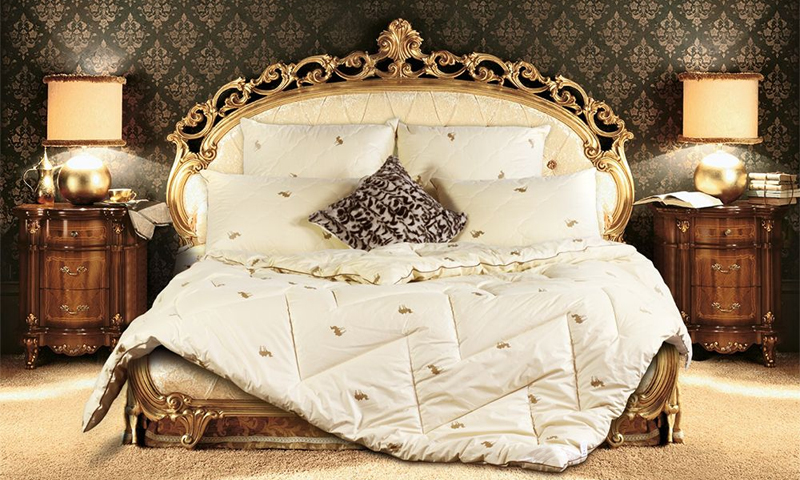
1. Prices for a duvet start from 3000 rubles. for the product of domestic producers and can reach 30 thousand, if it is an import model from a famous brand.
2. For a blanket will have to pay from 600 to 24,000 rubles. Here, not only the name of the manufacturer, but also the season of purchase will play its role (by the winter prices will increase a little).
3. Cotton blankets are the cheapest: their cost will not exceed 750-6000 rubles.
4. Synthetics based on polyester fiber can be purchased at prices ranging from 500 to 14,000 rubles.
5. A product with silk filling will empty your wallet for a more serious amount - from 2.5 to 65 thousand rubles.
6. Blankets with vegetable stuffing made of bamboo or eucalyptus are in the same price category from 500 to 20-27 thousand rubles. And the lower the percentage of natural fibers, the lower the cost of the finished product.
It will be interesting to friends too





